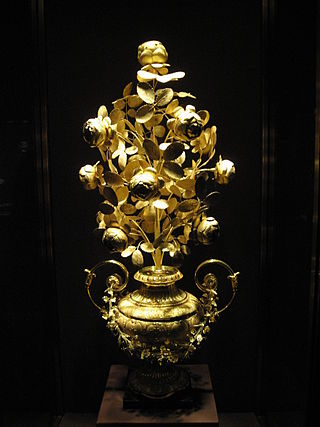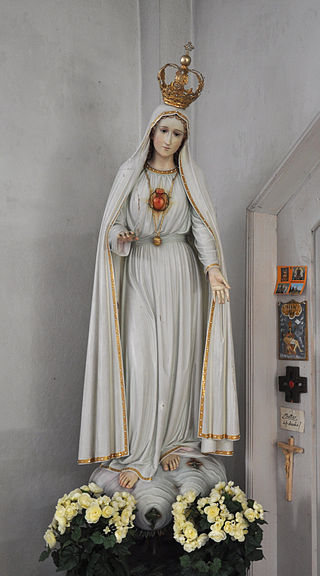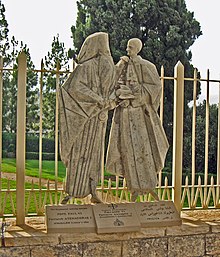
Pope John Paul II was head of the Catholic Church and sovereign of the Vatican City State from 1978 until his death in 2005. He was later canonised as Pope Saint John Paul II.

Pope Paul VI was head of the Catholic Church and sovereign of the Vatican City State from 21 June 1963 to his death in August 1978. Succeeding John XXIII, he continued the Second Vatican Council, which he closed in 1965, implementing its numerous reforms. He fostered improved ecumenical relations with Eastern Orthodox and Protestant churches, which resulted in many historic meetings and agreements. In January 1964, he flew to the Hashemite Kingdom of Jordan. This was the first time a reigning pontiff had flown on an airplane, the first papal pilgrimage to the Holy Land, and the first time a Pope had left Italy in more than a century.

Pope Benedict XVI was the head of the Catholic Church and sovereign of the Vatican City State from 19 April 2005 until his resignation on 28 February 2013. Benedict's election as pope occurred in the 2005 papal conclave that followed the death of Pope John Paul II. Benedict chose to be known as "Pope emeritus" upon his resignation, and he retained this title until his death in December 2022.

The Dicastery for the Doctrine of the Faith (DDF) is the oldest among the departments of the Roman Curia. Its seat is the Palace of the Holy Office in Rome. It was founded to defend the Catholic Church from heresy and is the body responsible for promulgating and defending Catholic doctrine.

The Mass of Paul VI, also known as the Ordinary Form or Novus Ordo, is currently the most commonly used liturgy in the Catholic Church. It was promulgated by Pope Paul VI in 1969 and its liturgical books were published in 1970; those books were then revised in 1975, they were revised again by Pope John Paul II in 2000, and a third revision was published in 2002.

Traditionalist Catholicism is a movement encompassing members of the Catholic Church and offshoot groups of the Catholic Church that emphasizes beliefs, practices, customs, traditions, liturgical forms, devotions and presentations of teaching associated with the Catholic Church before the Second Vatican Council (1962–65). Traditionalist Catholics particularly emphasize the Tridentine Mass, the Roman Rite liturgy largely replaced in general use by the post-Second Vatican Council Mass of Paul VI.

The Catholic Church, also known as the Roman Catholic Church, is the largest Christian church, with 1.3 billion baptized Catholics worldwide as of 2019. It is among the world's oldest and largest international institutions, and has played a prominent role in the history and development of Western civilization. The church consists of 24 sui iuris churches, including the Latin Church and 23 Eastern Catholic Churches, which comprise almost 3,500 dioceses and eparchies located around the world. The pope, who is the bishop of Rome, is the chief pastor of the church. The bishopric of Rome, known as the Holy See, is the central governing authority of the church. The administrative body of the Holy See, the Roman Curia, has its principal offices in Vatican City, a small enclave of the Italian city of Rome, of which the pope is head of state.

The Golden Rose is a gold ornament, which popes of the Catholic Church have traditionally blessed annually. It is occasionally conferred as a token of reverence or affection. Recipients have included churches and sanctuaries, royalty, military figures, and governments.

Jozef Tomko was a Slovak prelate of the Catholic Church who held positions in the Roman Curia from 1962 until he retired in 2007. He was prefect of the Congregation for the Evangelization of Peoples from 1985 to 2001 and president of the Pontifical Committee for International Eucharistic Congresses from 2001 to 2007. He was made a cardinal in 1985.

The consecration of Russia to the Immaculate Heart of Mary by a reigning pope was requested during a Marian apparition by Our Lady of Fátima on 13 July 1917, according to Lúcia dos Santos, one of the three visionaries who claimed to have seen the apparition. Sister Lucia said that at different times the Blessed Virgin Mary had given her a message of promise that the consecration of Russia to the Immaculate Heart of Mary would usher in a period of world peace.

Valerian Gracias was an Indian Cardinal of the Roman Catholic Church. He served as Archbishop of Bombay from 1950 until his death and was elevated to the rank of cardinal in 1953 by Pope Pius XII.

The current United States Ambassador to the Holy See is Joe Donnelly, who replaced the ad interim Chargé d'Affaires, Patrick Connell, on April 11, 2021. The Holy See is represented by its apostolic nuncio, Archbishop Christophe Pierre, who assumed office on April 12, 2016. The U.S. Embassy to the Holy See is located in Rome, in the Villa Domiziana. The Nunciature to the United States is located in Washington, D.C., at 3339 Massachusetts Avenue, N.W.

India-Holy See relations are the bilateral relations between the India and Holy See, which is sovereign over the Vatican City. Formal bilateral relations between the two exist since 12 June 1948. An Apostolic Delegation existed from 1881. The Holy See has a nunciature in New Delhi while India has accredited its embassy in Bern, Switzerland to the Holy See as well. India's Ambassador in Bern has traditionally been accredited to the Holy See. In a break from tradition, it was announced in October 2020 that Jaideep Mazumdar, India's ambassador to Austria would be the next ambassador to the Holy See. Archbishop Leopoldo Girelli was appointed as the Apostolic Nuncio to India in March 2021.

Holy See and Indonesia established diplomatic relations in 1950. Relations are important as part of global interfaith dialogue, because Indonesia has the world's largest Muslim-majority population. Indonesia recognizes Roman Catholicism as one of its six approved religions. The Holy See has a nunciature in Jakarta, while Indonesia has an embassy in Rome.

Papal travel outside Rome has been historically rare, and voluntary travel of the pope was non-existent for the first 500 years. Pope John Paul II (1978–2005) undertook more pastoral trips than all his predecessors combined. Pope Francis (2013–present), Pope Paul VI (1963–1978) and Pope Benedict XVI (2005–2013) also travelled globally, the latter to a lesser extent due to his advanced age.

Holy See–Philippines relations refers to the relations between the Holy See and the Philippines. As one of two Catholic-majority countries in Asia, the Philippines enjoys significant relations with the Holy See. The Holy See has a nunciature in Manila, and the Philippines has an embassy to the Holy See based in Rome.

















